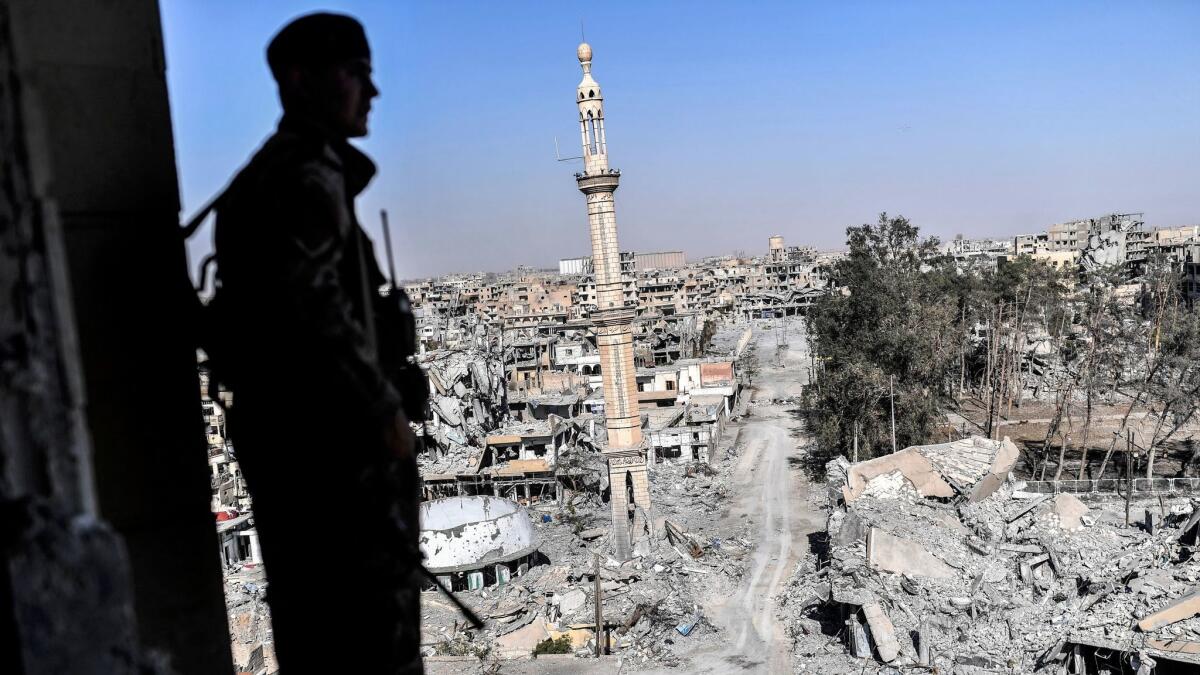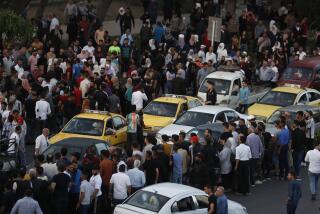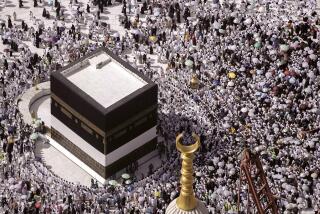What was life like in Syria’s Raqqah, the fallen capital of Islamic State’s ‘caliphate’?
Before it fell under the sway of Islamic State in January 2014, the Syrian crossroads city of Raqqah, on the northern banks of the Euphrates River in historic Mesopotamia, had lived out a richly layered past under a succession of empires.
Down through the centuries, it was an Ottoman trading post, a desert garrison and a cotton-rich commercial capital, known for gentler arts like its classic blue-glazed ceramics.
But the last three years and nine months marked what may have been its grimmest chapter.
Under the militants’ rule, Raqqawis — as the people of what was once Syria’s sixth-largest city are called — lived in terror of floggings, beheadings, and a pervasive network of Islamic State spies eager to sniff out any sign of resistance to the militant group’s imposition of stringent sharia law. Seemingly minor infractions — smoking, a man wearing too-long pants or a too-short beard, a woman failing to completely cover her face in public — could lead to harsh punishment.
Here is some background on the de facto capital of Islamic State’s self-proclaimed caliphate, which a U.S.-backed Syrian force on Tuesday declared liberated from the militants.
Why was Raqqah so symbolically important to Islamic State?
The group’s founding mythology centers on a modern-day reimagining of what it believes was Islam’s golden age. Raqqah’s history offered a convenient means of evoking past glories: It had been the capital of a caliphate — a Muslim ruler’s administrative jurisdiction — in the late 8th and early 9th centuries, when the Abbasid caliph Harun Rashid brought his imperial seat to the city from Baghdad.
In a deliberate echo, Islamic State’s leader Abu Bakr Baghdadi would claim the title of caliph for himself a few months after Raqqah’s conquest. His then fast-expanding realm in Syria and Iraq, by the group’s logic, was a caliphate – a bold departure from jihadist tradition of fielding a nimble guerrilla army rather than seeking to seize and hold territory.
Under Islamic State, Raqqah was unquestionably an emblem, but one with an array of practical roles: administrative center, operations hub, recruitment magnet for foreign jihadis, planning headquarters for sophisticated attacks including major strikes in Paris in 2015 and Brussels the following year. Raqqah was central to the trappings of statehood the group managed to achieve: coining money, levying taxes, printing passports, setting up a mind-numbing bureaucracy, flying its ubiquitous black flag.
The city’s practical importance as a capital had faded even before the battle to recapture it entered a decisive phase four months ago, but its loss, coupled with the retaking of Iraq’s second-largest city of Mosul in July, was seen as heralding the end of the so-called caliphate, at least as a territorial entity.
How did Islamic State control the city’s population?
Some 300,000 people, the majority of them Sunni Arabs but with substantial minority groups, including Kurds and Christians and Shiite Muslims, were living in Raqqah when nationwide protests erupted against the government of President Bashar Assad in 2011. Strategically located 230 miles northeast of Damascus, the nation’s capital, Raqqah was the first major city to fall to Syrian rebels, but infighting among them led to a takeover in early 2014 by Al Qaeda remnants that had coalesced into Islamic State.
The group’s fighters imposed a reign of terror that included baroque punishments, public executions, sexual enslavement of captives and the indoctrination of children. But it also used a clever means of control that would become a trademark elsewhere: if people kept quiet and followed the group’s rigorous rules, they could live some semblance of their normal lives, even amid the larger chaos of Syria’s civil war. Resistance often took the form of clandestine communication with the outside world, including the work of an online collective called Raqqa Is Being Slaughtered Silently.
What were some of the worst atrocities committed in Raqqah?
In addition to the suffering of Raqqah’s own people and of Islamic State captives from ethnic groups such as the Yazidis, a procession of Western hostages, including American journalists James Foley and Steven Sotloff, met a gruesome fate in the featureless dry hills outside the city. Their beheadings were the subjects of slick, highly orchestrated propaganda videos that Islamic State gleefully used to capture worldwide attention and boost recruitment of foreign fighters. The group’s brutality was calculatedly theatrical, played out in acts such as the burning alive in a cage of a Jordanian pilot captured near Raqqah – a killing also captured on video.
Raqqah was also where the young American aid worker Kayla Mueller is thought to have spent the entirety of her captivity. She was sexually enslaved by Baghdadi, according to those held with her, but helped two young Yazidi girls imprisoned in the same household to escape. Islamic State said Mueller died in an airstrike by the U.S.-led coalition confronting Islamic State; U.S. officials disputed that account but confirmed her death to her family in 2015.
What happens now?
Raqqah lies in ruins, much of it leveled by ground fighting and by coalition airstrikes which, by the tallies of monitoring groups, killed hundreds of civilians. The humanitarian group Save the Children said Tuesday that some 270,000 people would require urgent assistance, and probably faced years in camps for the displaced. Islamic State’s fighters have dispersed or regrouped farther downstream along the Euphrates to towns and villages near Dair Alzour. But few observers expect the group to fade away altogether.

More to Read
Sign up for Essential California
The most important California stories and recommendations in your inbox every morning.
You may occasionally receive promotional content from the Los Angeles Times.









